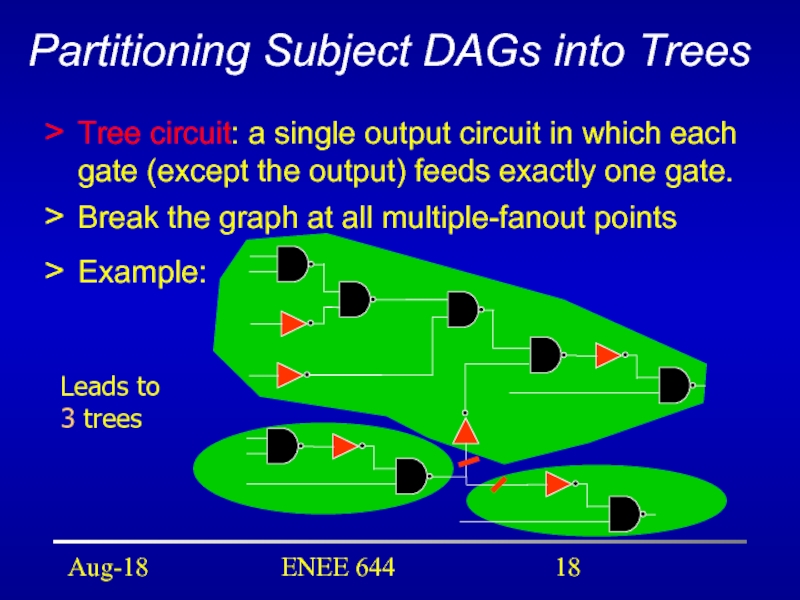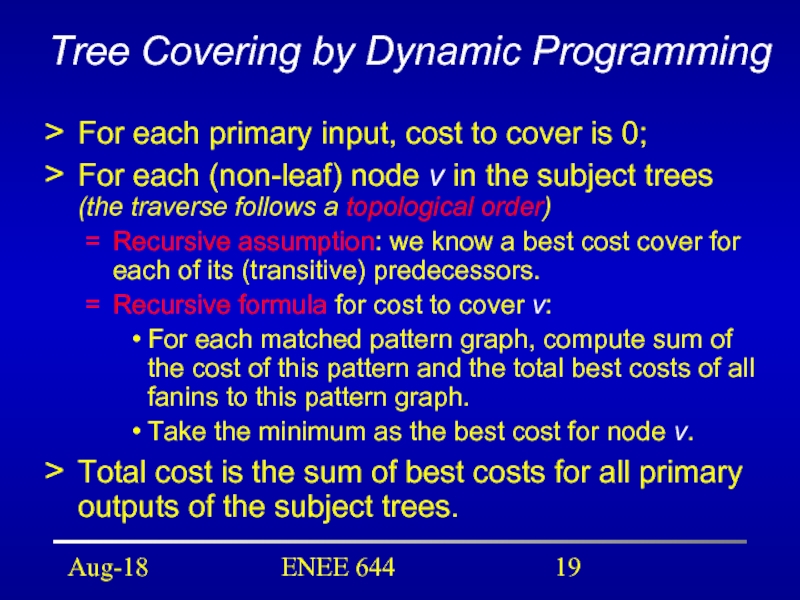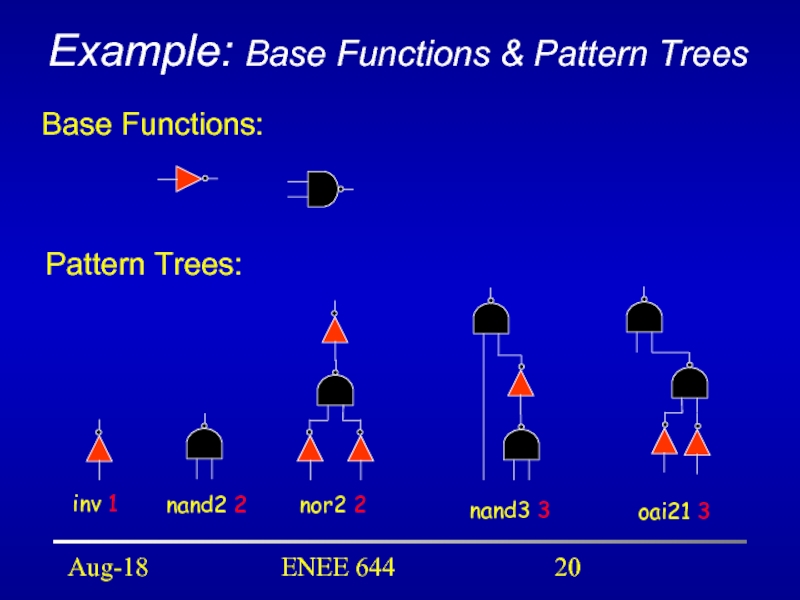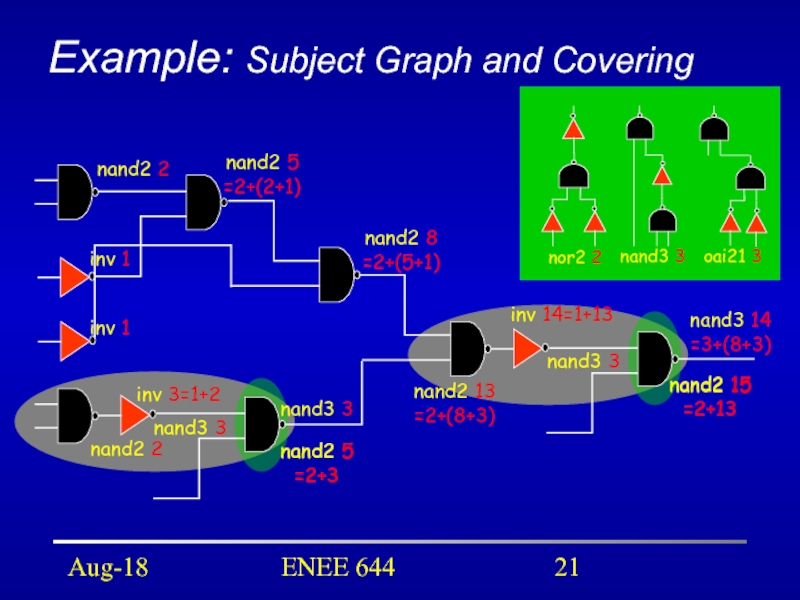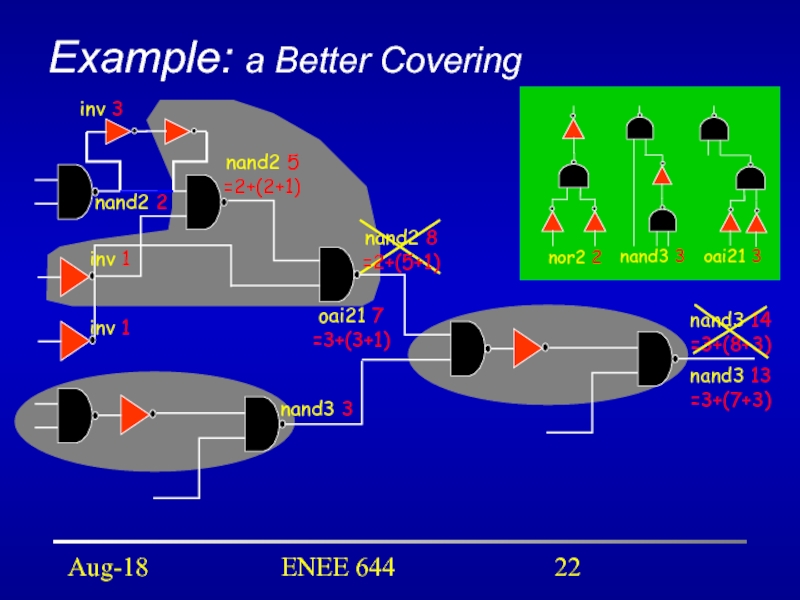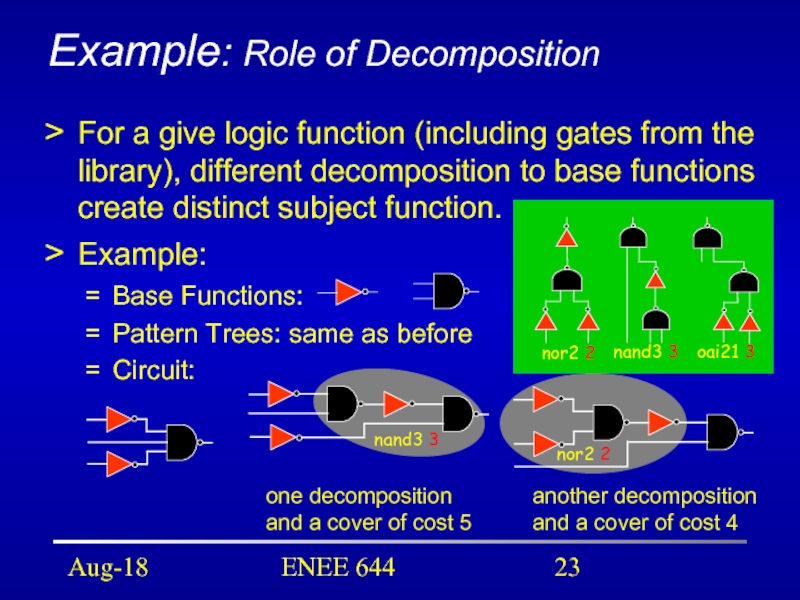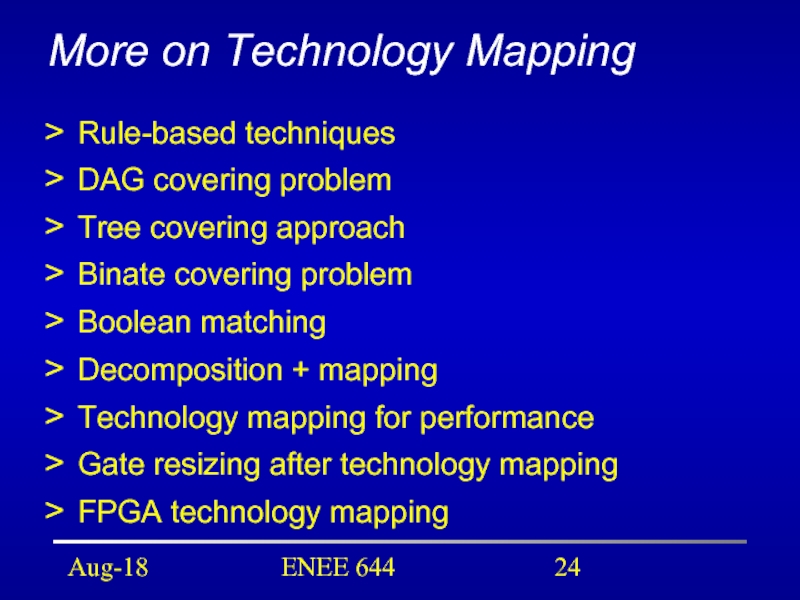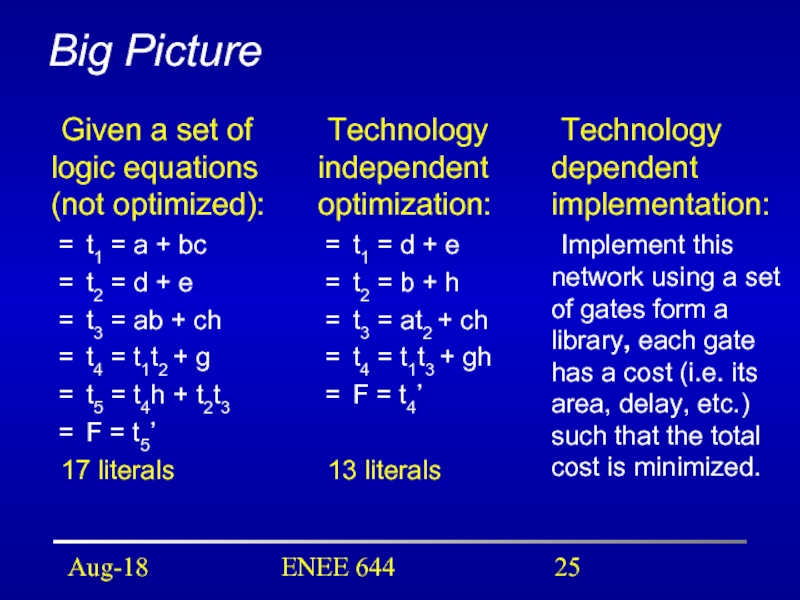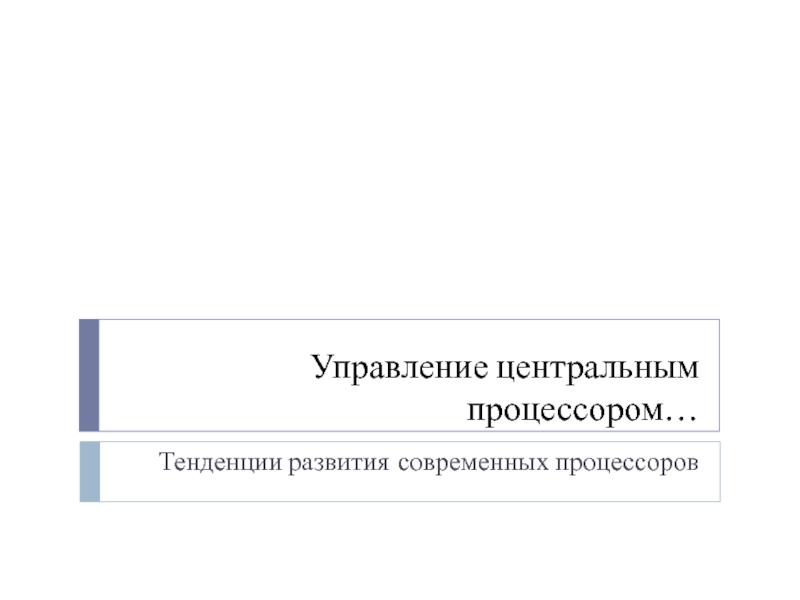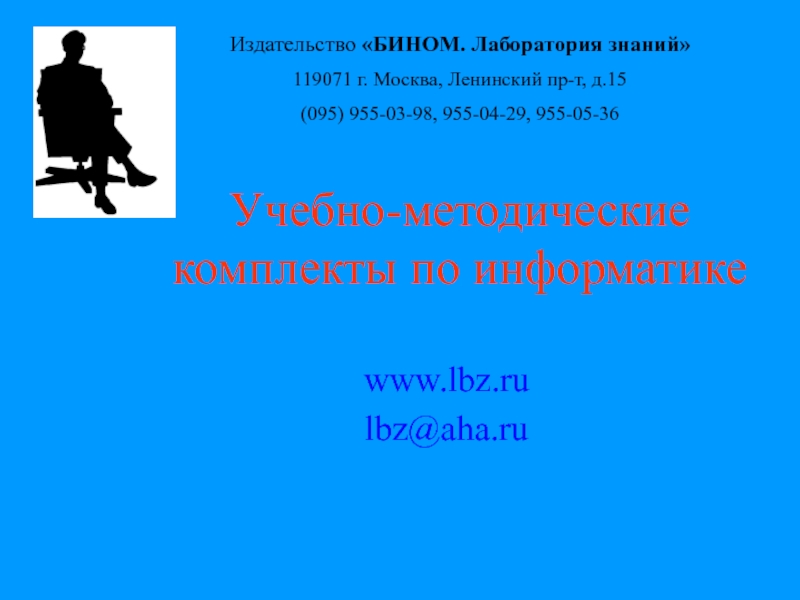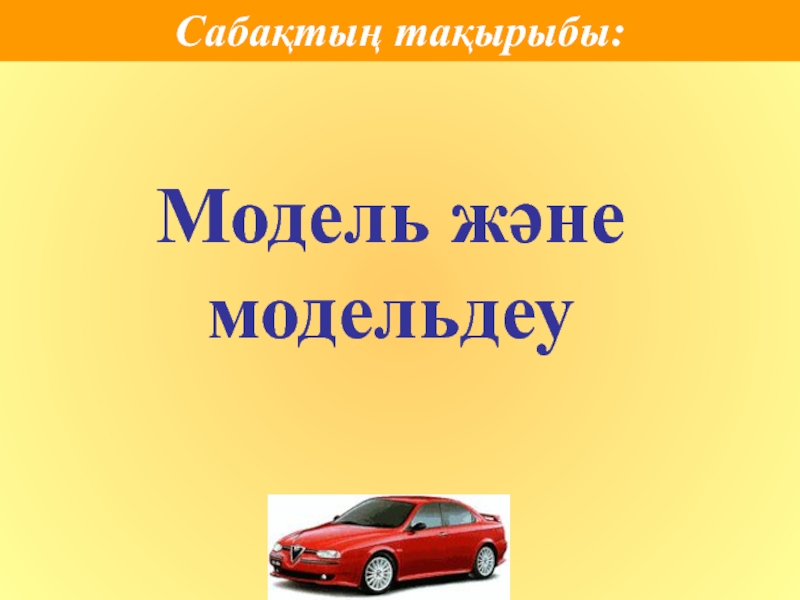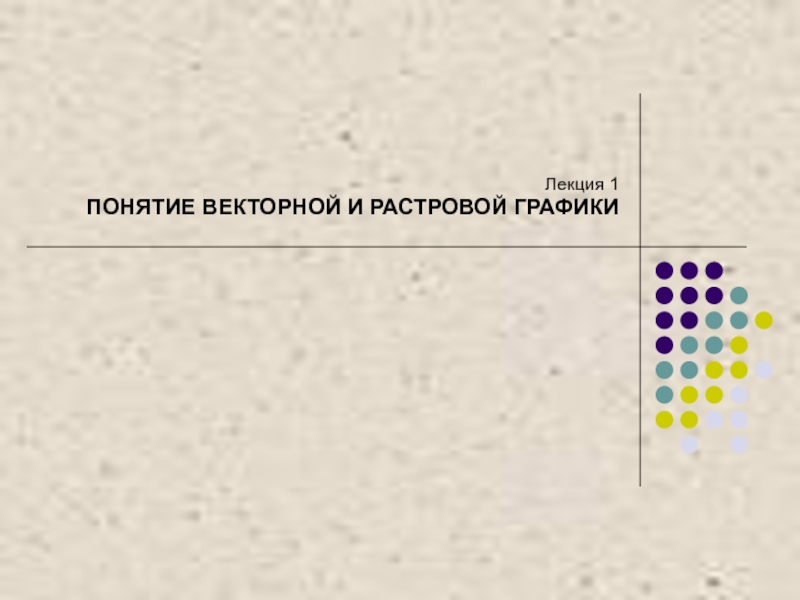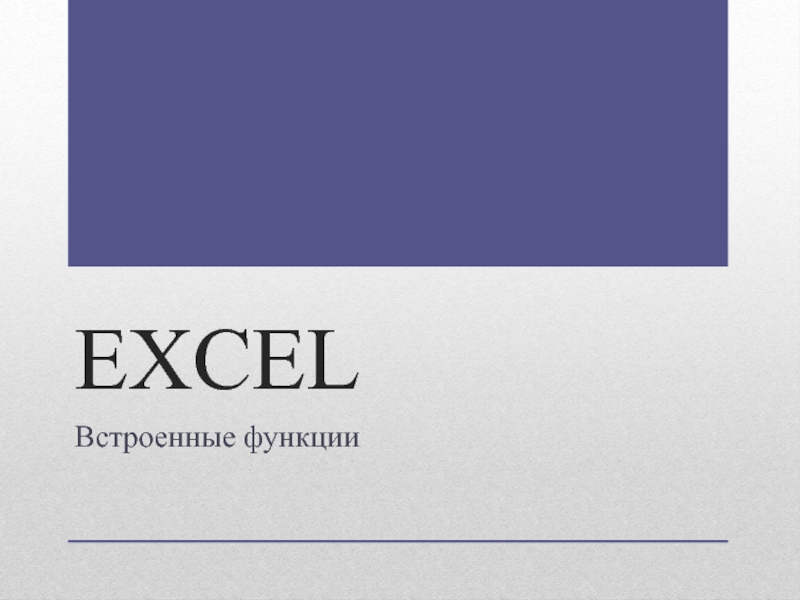- Главная
- Разное
- Дизайн
- Бизнес и предпринимательство
- Аналитика
- Образование
- Развлечения
- Красота и здоровье
- Финансы
- Государство
- Путешествия
- Спорт
- Недвижимость
- Армия
- Графика
- Культурология
- Еда и кулинария
- Лингвистика
- Английский язык
- Астрономия
- Алгебра
- Биология
- География
- Детские презентации
- Информатика
- История
- Литература
- Маркетинг
- Математика
- Медицина
- Менеджмент
- Музыка
- МХК
- Немецкий язык
- ОБЖ
- Обществознание
- Окружающий мир
- Педагогика
- Русский язык
- Технология
- Физика
- Философия
- Химия
- Шаблоны, картинки для презентаций
- Экология
- Экономика
- Юриспруденция
Technology Mapping презентация
Содержание
- 1. Technology Mapping
- 2. Aug-18 ENEE 644 Outline What is Technology
- 3. Aug-18 ENEE 644 Technology Mapping Technology mapping
- 4. Aug-18 ENEE 644 Technology Mapping Algorithms Basic
- 5. Aug-18 ENEE 644 Outline What is Technology
- 6. Aug-18 ENEE 644 Base Functions Base function
- 7. Aug-18 ENEE 644 Subject Graph Subject graph
- 8. Aug-18 ENEE 644 Example: Subject Graph
- 9. Aug-18 ENEE 644 Pattern Graph For any
- 10. Aug-18 ENEE 644 Example: Pattern Graphs for
- 11. Aug-18 ENEE 644 Cover A cover is
- 12. Aug-18 ENEE 644
- 13. Aug-18 ENEE 644
- 14. Aug-18 ENEE 644
- 15. Aug-18 ENEE 644 Graph Covering Formation Technology
- 16. Aug-18 ENEE 644 Generic Algorithmic Approach
- 17. Aug-18 ENEE 644 Optimal Tree Covering by
- 18. Aug-18 ENEE 644 Partitioning Subject DAGs into
- 19. Aug-18 ENEE 644 Tree Covering by Dynamic
- 20. Aug-18 ENEE 644 Example: Base Functions &
- 21. Aug-18 ENEE 644 Example: Subject Graph and
- 22. Aug-18 ENEE 644 Example: a Better Covering
- 23. Aug-18 ENEE 644 Example: Role
- 24. Aug-18 ENEE 644 More on Technology Mapping
- 25. Aug-18 ENEE 644 Big Picture Given a
Слайд 2Aug-18
ENEE 644
Outline
What is Technology Mapping?
Technology Mapping Algorithms
Technology Mapping as Graph Covering
Choosing
Creating subject graph
Tree covering problem
Decomposition
Delay Optimization
Слайд 3Aug-18
ENEE 644
Technology Mapping
Technology mapping is the phase of logic synthesis when
Technology mapping is normally done after technology independent optimization.
Why technology mapping?
Straight implementation may not be good. For example, F = abcdef as a 6-input AND gate cause a long delay.
Gates in the library are pre-designed, they are usually optimized in terms of area, delay, power, etc.
Fastest gates along the critical path, area-efficient gates (combination) off the critical path.
Слайд 4Aug-18
ENEE 644
Technology Mapping Algorithms
Basic Requirements:
Provide high quality solutions (circuits).
Adapt to different
Library may have irregular logic functions.
Support different cost functions.
Transistor count, level count, detailed models for area, delay, and power, etc.
Be efficient in run time.
Two Approaches:
Rule-based techniques
Graph covering techniques (DAG)
Слайд 5Aug-18
ENEE 644
Outline
What is Technology Mapping?
Technology Mapping Algorithms
Technology Mapping as Graph Covering
Choosing
Creating subject graph
Tree covering problem
Decomposition
Delay Optimization
Слайд 6Aug-18
ENEE 644
Base Functions
Base function set is a set of gates which
2-input AND, 2-input OR, and NOT
2-input NAND (and NOT)
Recall: A gate (or a set of gates) is universal if it can implement all the Boolean functions, or equivalently, it can implement 2-input AND, 2-input OR, and NOT.
Choose of base functions:
Universal: able to implement any functions.
Optimal: implement functions efficiently.
Introduce redundant gates: 2-input NAND and NOT.
Слайд 7Aug-18
ENEE 644
Subject Graph
Subject graph is the graph representation of a logic
For a given base function set, subject graph for a gate may not be unique.
NAND(a,b,c,d) =NAND(NOT(NAND(a,b)),NOT(NAND(c,d))) =NAND(a,NOT(NAND(b,NOT(NAND(c,d)))))
All distinct subject graphs of the same logic have to be considered to obtain global optimal design.
Слайд 8Aug-18
ENEE 644
Example: Subject Graph
t1 = d + e
t2 = b +
t3 = at2 + c
t4 = t1t3 + fgh
F = t4’
t1
t2
t3
t4
inv
nand
base
Слайд 9Aug-18
ENEE 644
Pattern Graph
For any library gate, its logic function can be
A pattern graph is a subject graph when the function represents a library gate.
Similarly, all pattern graphs for the same library gate have to be considered.
Tip on choosing base function set: Choose those that provide a small set of pattern graphs.
Слайд 10Aug-18
ENEE 644
Example: Pattern Graphs for the Library
inv(1)
nand3 (3)
oai22 (4)
nor(2)
nor3 (3)
xor (5)
aoi21
nand2(2)
… …
Слайд 11Aug-18
ENEE 644
Cover
A cover is a collection of pattern graphs so that:
every
each input required by a pattern graph is actually an output of some other pattern graph (i.e. the inputs of one library gate must be outputs from other gates.)
Cost of a Cover
Area: total area of the library gates used (I.e. gates in the cover).
Delay: total delay along the critical path.
Power: total power dissipation of the cover.
Слайд 12Aug-18
ENEE 644
Example: Subject Graph Cover by Base
F
f
g
d
e
h
b
a
c
Total cost = 23
(7
8 NANDs)
t1 = d + e
t2 = b + h
t3 = at2 + c
t4 = t1t3 + fgh
F = t4’
inv (1)
nand (2)
base
Слайд 13Aug-18
ENEE 644
Example: Better Cover Using the Library
F
f
g
d
e
h
b
a
c
aoi22(4)
and2(3)
or2(3)
or2(3)
Total cost = 18
nand2(2)
nand2(2)
inv(1)
t1 =
t2 = b + h
t3 = at2 + c
t4 = t1t3 + fgh
F = t4’
Слайд 14Aug-18
ENEE 644
Example: Alternate Covering
F
f
g
d
e
h
b
a
c
nand3(3)
oai21(3)
oai21 (3)
Total cost = 15
and2(3)
inv(1)
nand2(2)
t1 = d +
t2 = b + h
t3 = at2 + c
t4 = t1t3 + fgh
F = t4’
Слайд 15Aug-18
ENEE 644
Graph Covering Formation
Technology mapping problem: Find a minimum cost cover
DAG-covering-by-DAG is hard
NP-hard for a simple case:
Only 3 pattern graphs (NOT, 2-input NAND, 2-input NOR)
Each node in the subject graph has no more than 2 fanins and fanouts.
Do We Need to Solve the Problem Optimally?
Input logic from technology-independent optimization
Numerous subject graphs for the same logic network
Слайд 16Aug-18
ENEE 644
Generic Algorithmic Approach
Represent each logic function of the network
Generate all possible pattern graphs (DAGs)for each gate in the technology library;
Find an optimal-cost covering of the subject DAG using the collection of pattern DAGs.
Question: how to solve this NP-hard problem?
If subject DAG and pattern DAG’s are trees, an efficient algorithm exists.
Слайд 17Aug-18
ENEE 644
Optimal Tree Covering by Trees
Proposed by Keutzer in program DAGON[DAC’87]
Basic
Procedure:
Partition the subject graph into trees;
Cover each tree optimally;
Piece the tree-cover into a cover for the subject graph.
Complexity: finding all sub-trees of the subject graph that are isomorphic to a pattern tree. It is linear in the size of subject tree and the size of the pattern trees.
Слайд 18Aug-18
ENEE 644
Partitioning Subject DAGs into Trees
Tree circuit: a single output circuit
Break the graph at all multiple-fanout points
Example:
Слайд 19Aug-18
ENEE 644
Tree Covering by Dynamic Programming
For each primary input, cost to
For each (non-leaf) node v in the subject trees (the traverse follows a topological order)
Recursive assumption: we know a best cost cover for each of its (transitive) predecessors.
Recursive formula for cost to cover v:
For each matched pattern graph, compute sum of the cost of this pattern and the total best costs of all fanins to this pattern graph.
Take the minimum as the best cost for node v.
Total cost is the sum of best costs for all primary outputs of the subject trees.
Слайд 20Aug-18
ENEE 644
Example: Base Functions & Pattern Trees
inv 1
nand3 3
oai21 3
nor2 2
nand2
Base Functions:
Pattern Trees:
Слайд 21Aug-18
ENEE 644
Example: Subject Graph and Covering
inv 3=1+2
nand2 5
=2+(2+1)
nand2 8
=2+(5+1)
nand3 3
nand2 13
=2+(8+3)
inv
nand3 14
=3+(8+3)
Слайд 22Aug-18
ENEE 644
Example: a Better Covering
nand2 5
=2+(2+1)
nand2 8
=2+(5+1)
nand3 3
nand3 14
=3+(8+3)
nand2 2
inv 3
Слайд 23Aug-18
ENEE 644
Example: Role of Decomposition
For a give logic function (including gates
Example:
Base Functions:
Pattern Trees: same as before
Circuit:
one decomposition
and a cover of cost 5
another decomposition
and a cover of cost 4
nand3 3
nor2 2
Слайд 24Aug-18
ENEE 644
More on Technology Mapping
Rule-based techniques
DAG covering problem
Tree covering approach
Binate covering
Boolean matching
Decomposition + mapping
Technology mapping for performance
Gate resizing after technology mapping
FPGA technology mapping
Слайд 25Aug-18
ENEE 644
Big Picture
Given a set of logic equations (not optimized):
t1 =
t2 = d + e
t3 = ab + ch
t4 = t1t2 + g
t5 = t4h + t2t3
F = t5’
17 literals
Technology independent optimization:
t1 = d + e
t2 = b + h
t3 = at2 + ch
t4 = t1t3 + gh
F = t4’
13 literals
Technology dependent implementation:
Implement this network using a set of gates form a library, each gate has a cost (i.e. its area, delay, etc.) such that the total cost is minimized.
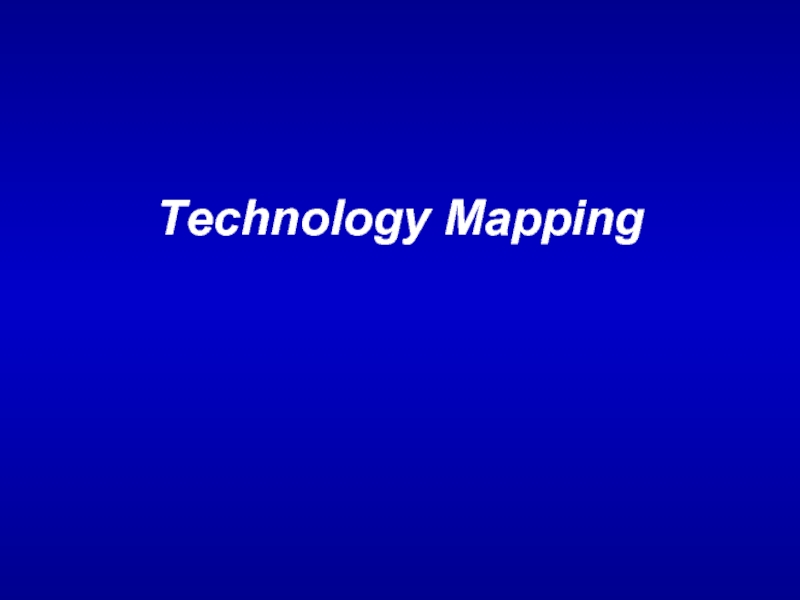
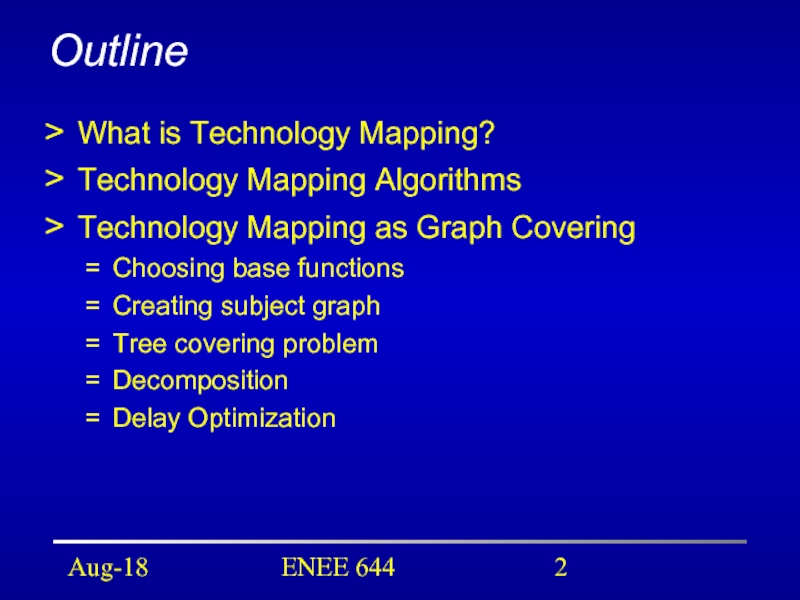
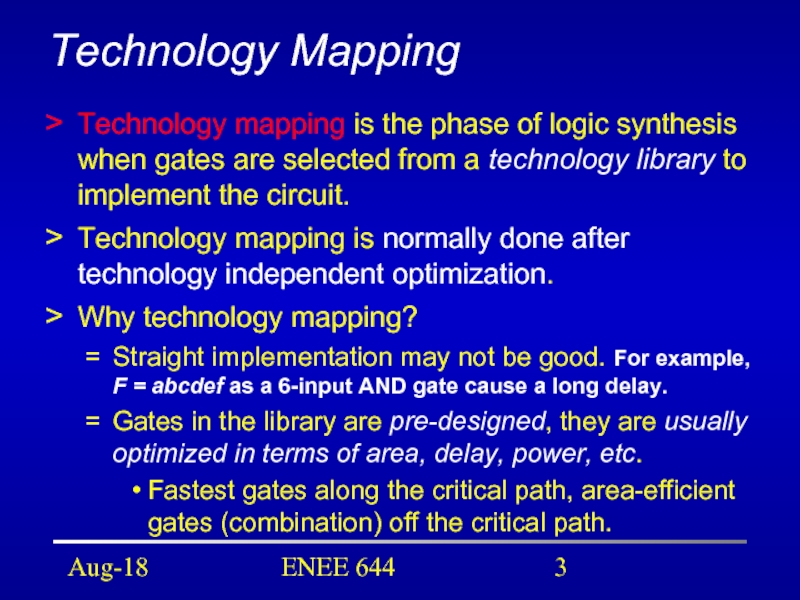
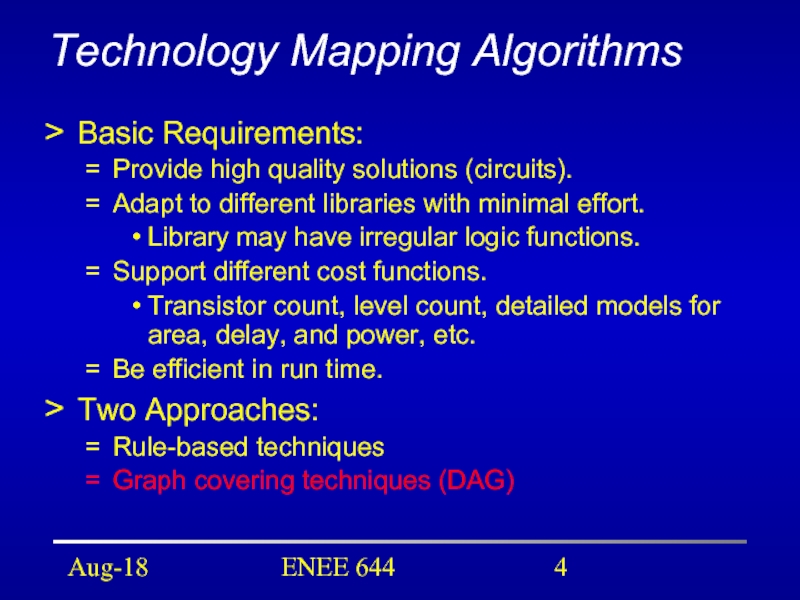
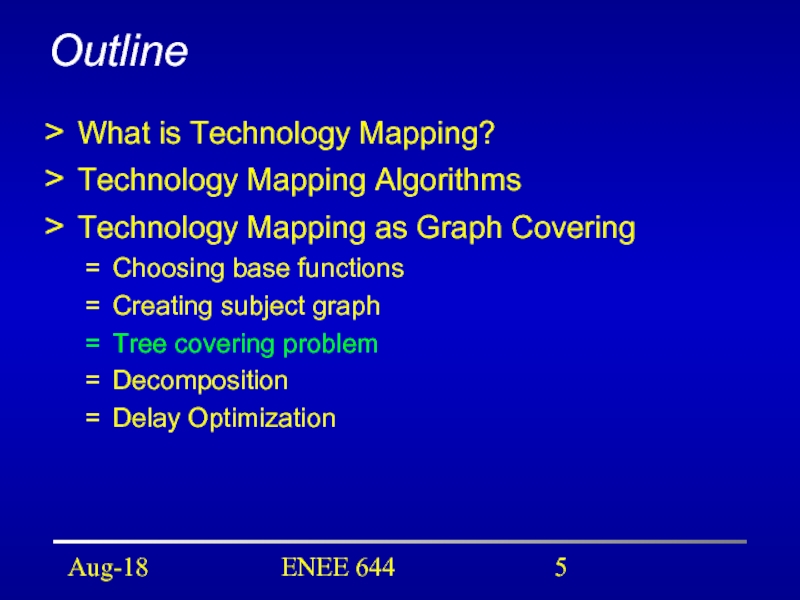
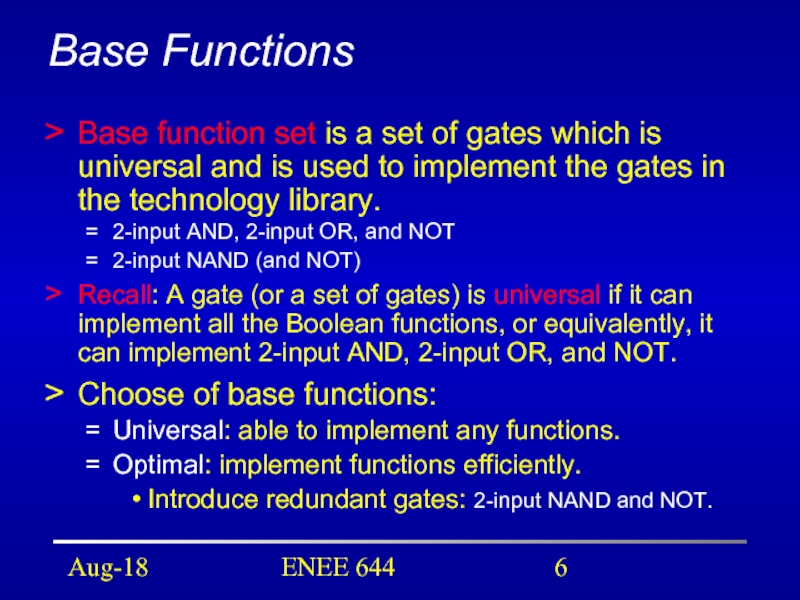
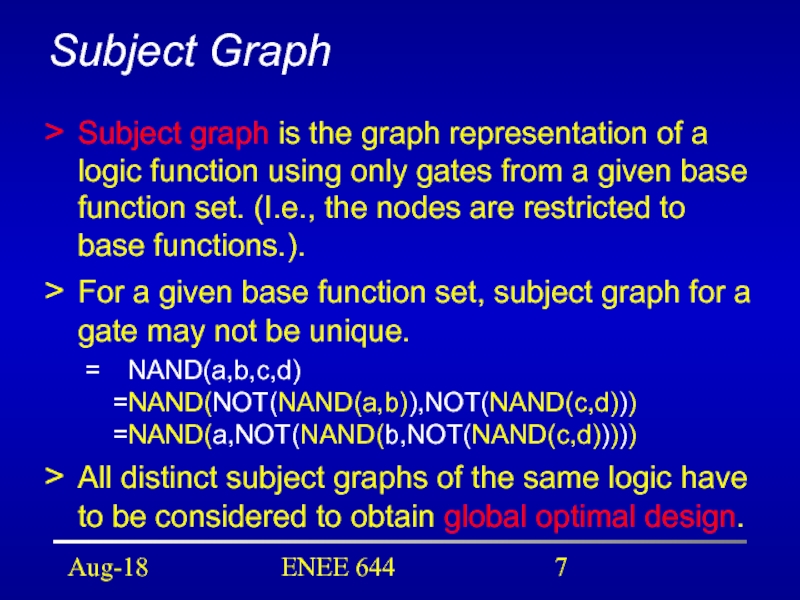
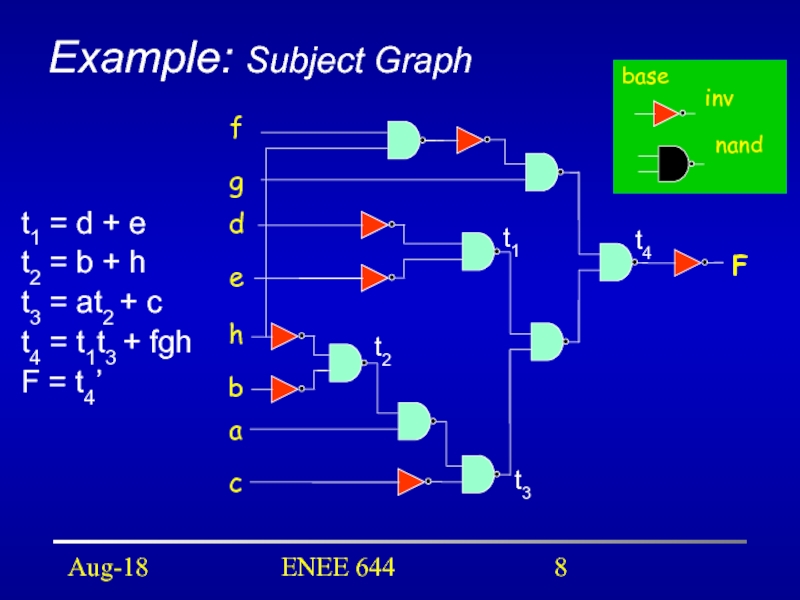
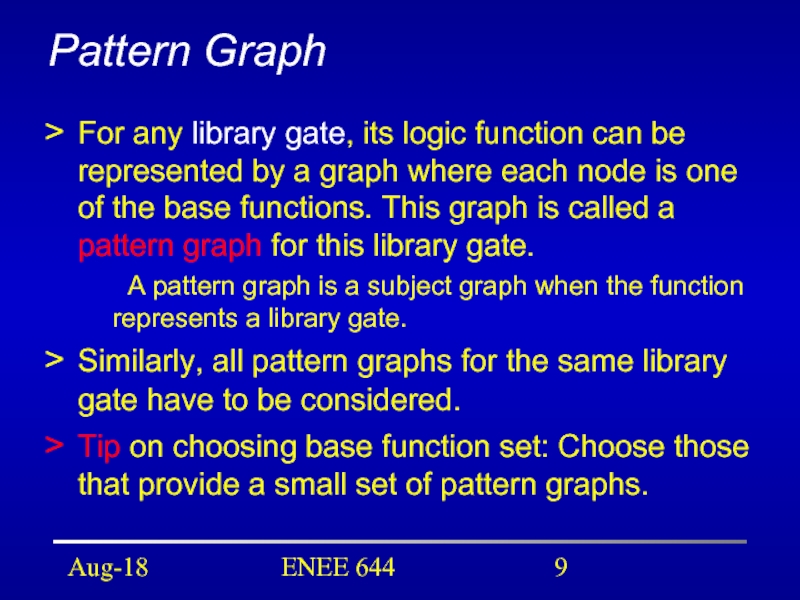
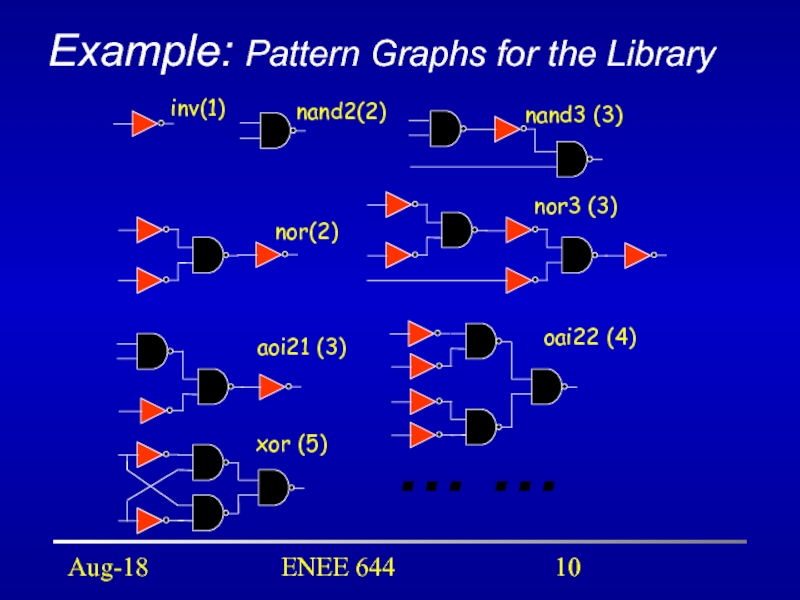
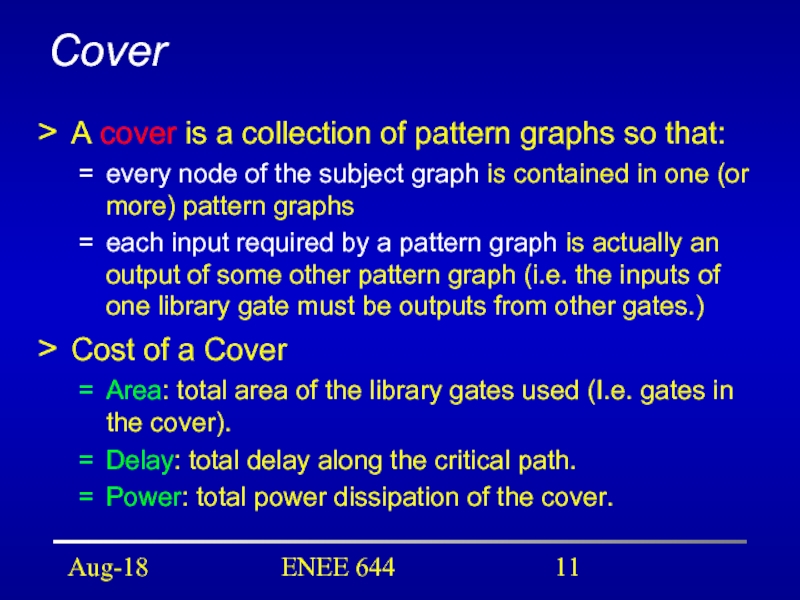
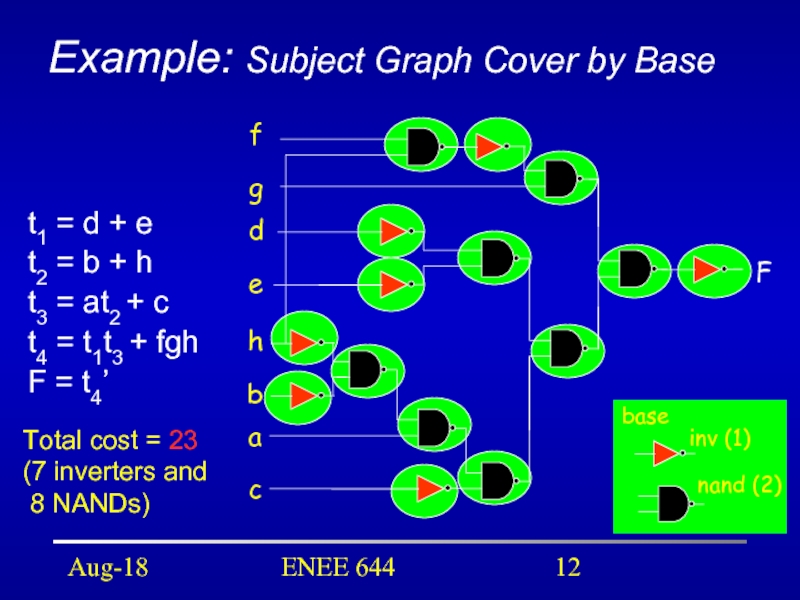
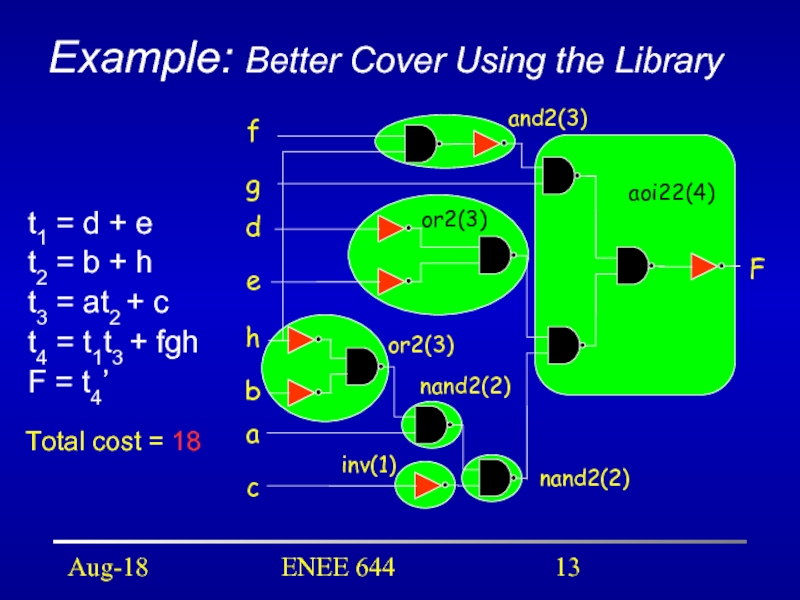
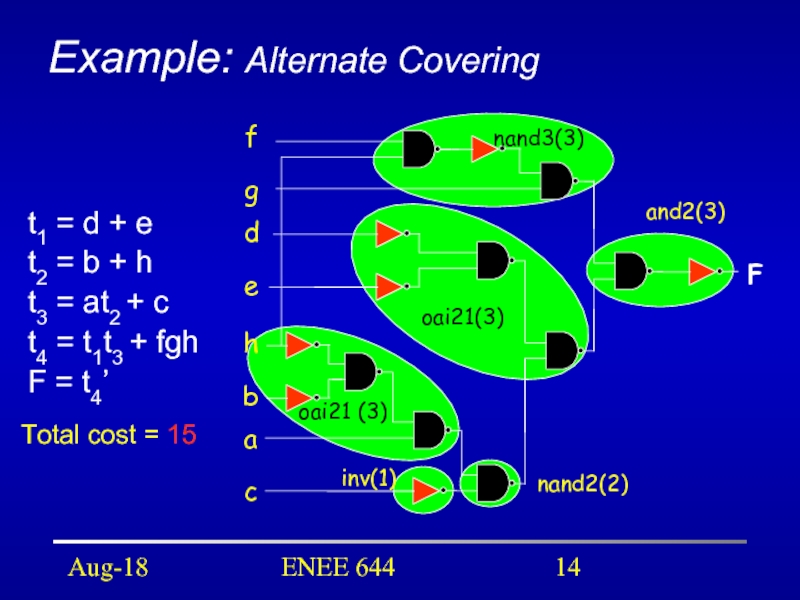
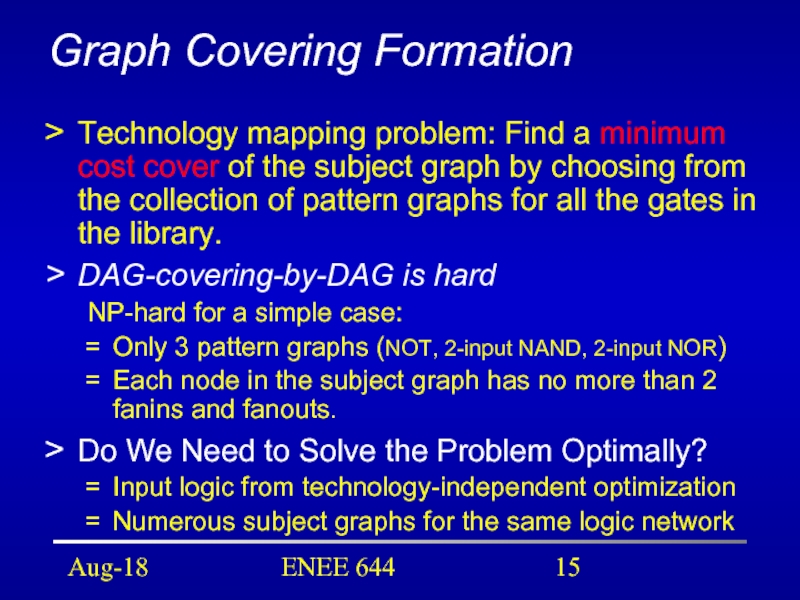
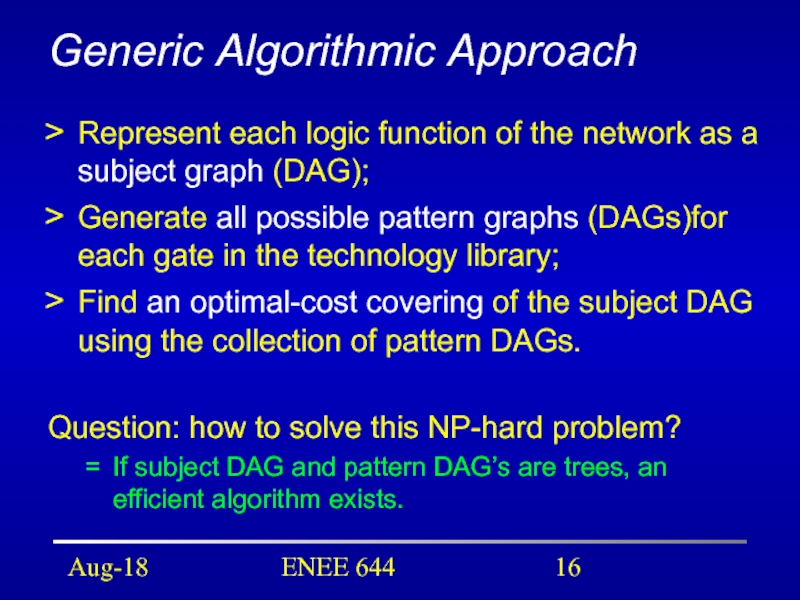
![Aug-18ENEE 644Optimal Tree Covering by TreesProposed by Keutzer in program DAGON[DAC’87]Basic idea: dynamic programming.Procedure:Partition the](/img/tmb/2/180287/7d69ad1e79009bb01ede8c205ce5f46f-800x.jpg)
